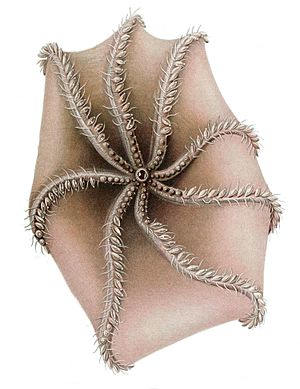Cirrina facts for kids
Quick facts for kids Cirrina |
|
|---|---|
 |
|
| Oral view of Cirrothauma murrayi showing single row of suckers and paired cirri | |
| Scientific classification |
|
| Kingdom: | Animalia |
| Phylum: | Mollusca |
| Class: | Cephalopoda |
| Order: | Octopoda |
| Suborder: | Cirrina Grimpe, 1916 sensu Felley et al., 2001 |
| Families | |
|
Opisthoteuthidae |
|
| Synonyms | |
|
|
Cirrina is one of the two main groups of octopus. These amazing creatures are also known as finned, deep-sea octopuses. They get their name from the two fins on their head. These paddle-shaped fins help them swim through the deep ocean. Cirrina octopuses also have a small internal shell. This shell gives their body some support.
Contents
What Makes Cirrina Special?
Cirrina octopuses are different from other octopuses. They have some unique features that help them live in the deep sea.
Fins for Swimming
One of the most noticeable features of Cirrina is their fins. They have two large fins that look like ears. These fins are on the sides of their head. They use these fins to move through the water. This is different from most octopuses, which usually crawl or use jet propulsion.
Internal Shell
Cirrina also have a small, U-shaped internal shell. This shell is made of cartilage. It is inside their body, not outside like a snail's shell. This internal shell helps support their fins. It also gives their body some structure.
Suckers and Cirri
Their arms have a single row of suckers. But they also have something special called cirri. Cirri are small, finger-like structures. They are next to each sucker. Scientists believe cirri help Cirrina find food. They might help them sense tiny particles in the water.
Webbed Arms
Many Cirrina species have a strong web of skin between their arms. This web can be very wide. It helps them move through the water like an umbrella. It also helps them catch food.
Where Do Cirrina Live?
Cirrina octopuses live in the deep parts of the ocean. They are found in waters all around the world.
Deep-Sea Homes
These octopuses live in very cold and dark environments. They can be found thousands of meters below the surface. Some species live deeper than 3,000 meters (about 10,000 feet). The deep sea is a challenging place to live. There is very little light and a lot of pressure.
Finding Food
In the deep sea, food can be scarce. Cirrina octopuses are thought to eat small crustaceans. They also eat tiny worms and other small creatures. They use their cirri and webbed arms to catch their prey.
Types of Cirrina Octopuses
There are several families within the Cirrina group. Each family has different species.
Opisthoteuthidae
This family includes the "flapjack" octopuses. They have very flattened bodies. They look a bit like pancakes. They often hover just above the seafloor.
Cirroteuthidae
These octopuses are often larger. They have a more typical octopus shape. They are known for their strong fins. They use these fins to swim actively in the water.
Stauroteuthidae
The most famous member of this family is Stauroteuthis syrtensis. This octopus is special because it can glow! It uses special light-producing organs called photophores on its suckers. This is very rare for an octopus.
Cirroctopodidae
This family includes octopuses that are also found in deep waters. They share the common features of fins and an internal shell.
How Do Cirrina Reproduce?
Scientists are still learning a lot about how Cirrina reproduce. It is hard to study them in their deep-sea homes.
Egg Laying
Like other octopuses, Cirrina lay eggs. The females likely lay their eggs on the seafloor. The eggs are often large. They can take a long time to hatch. This is common for deep-sea animals.
Life Cycle
The young octopuses hatch directly from the eggs. They do not go through a larval stage. This means they look like tiny versions of the adults when they hatch.
Conservation Status
Because Cirrina live in the deep sea, they are not often seen by humans. This makes it hard to know their exact numbers.
Threats
The main threats to deep-sea creatures like Cirrina are still being studied. Deep-sea fishing and mining could affect their habitats. Climate change might also impact the deep ocean.
Research Efforts
Scientists use special submersibles and robots to explore the deep sea. This helps them learn more about Cirrina. Understanding these creatures is important for protecting them.
See also
 In Spanish: Cirrina para niños
In Spanish: Cirrina para niños

